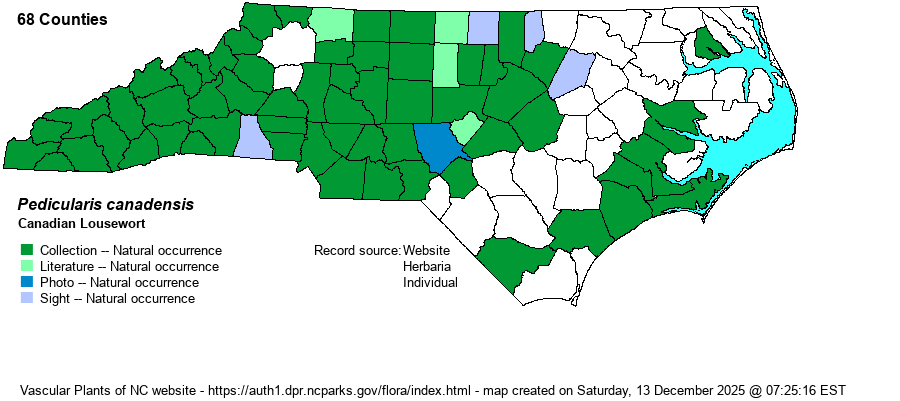| Author | L. | |
| Distribution | Throughout the Mountains and most of the Piedmont (with only a few counties lacking records). In the Coastal Plain, mostly found disjunctly in the lower parts of the province, in the southern counties from Beaufort to Columbus; sparingly along the western edge of this province (e.g., the Sandhills).
This is a widespread and numerous Eastern species, found in most counties across its range -- from eastern Canada south to northern FL and west to eastern TX. It has a very spotty range along the Coastal Plain. | |
| Abundance | Common in the Mountains, and frequent to common in the Piedmont. Rare and local in the eastern and southeastern Coastal Plain, only in rich soil sites (high pH); very rare to absent elsewhere in the province. | |
| Habitat | This is a species of mesic to moist forests, bottomlands, and stream banks; over most of the range it does not require high pH soil, but in the eastern Coastal Plain it does. It has a wide range of forested types in the state, and soil moisture and pH, but it does prefer moderate shade. | |
| Phenology | Blooms in the spring, from April into May; fruits from May to July. | |
| Identification | This is a familiar spring wildflower over the Piedmont and mountains, growing in the same places where many other spring-blooming plants are found. It is rather small, reaching only about 6-9 inches high. It has a basal rosette of numerous leaves, each being about 2 inches long and about 3/4-inch wide, highly dissected into about 10 or more pairs of pinnate lobes, quite fern-like. The single stem has a few pairs of opposite leaves, quite similar to the basal leaves but smaller, each strongly pinnately divided. The top of the stem is a very compact spike of a dozen or more medium-sized flowers, mostly tubular but with a hooded appearance, the top lobes curing down over the opening of the flower. Each flower is nearly 1-inch long, yellow to reddish-purple (often a mixture of yellow and purplish), and the effect is a rounded, bushy-looking inflorescence that is 1-2 inches across. Normally, the species can be identified just from the cluster of highly-dissected basal leaves, but the rounded cluster of numerous flowers is bound to catch attention. Though it can be local in a given county, not found in all suitable habitat, it normally can be seen on every few spring wildflower trips in the mountains and Piedmont. | |
| Taxonomic Comments | Some references give varieties for the species, but Weakley (2018) does not.
| |
| Other Common Name(s) | Wood-betony, Eastern Lousewort | |
| State Rank | S5 | |
| Global Rank | G5 | |
| State Status | | |
| US Status | | |
| USACE-agcp | FACU link |
| USACE-emp | FACU link |

